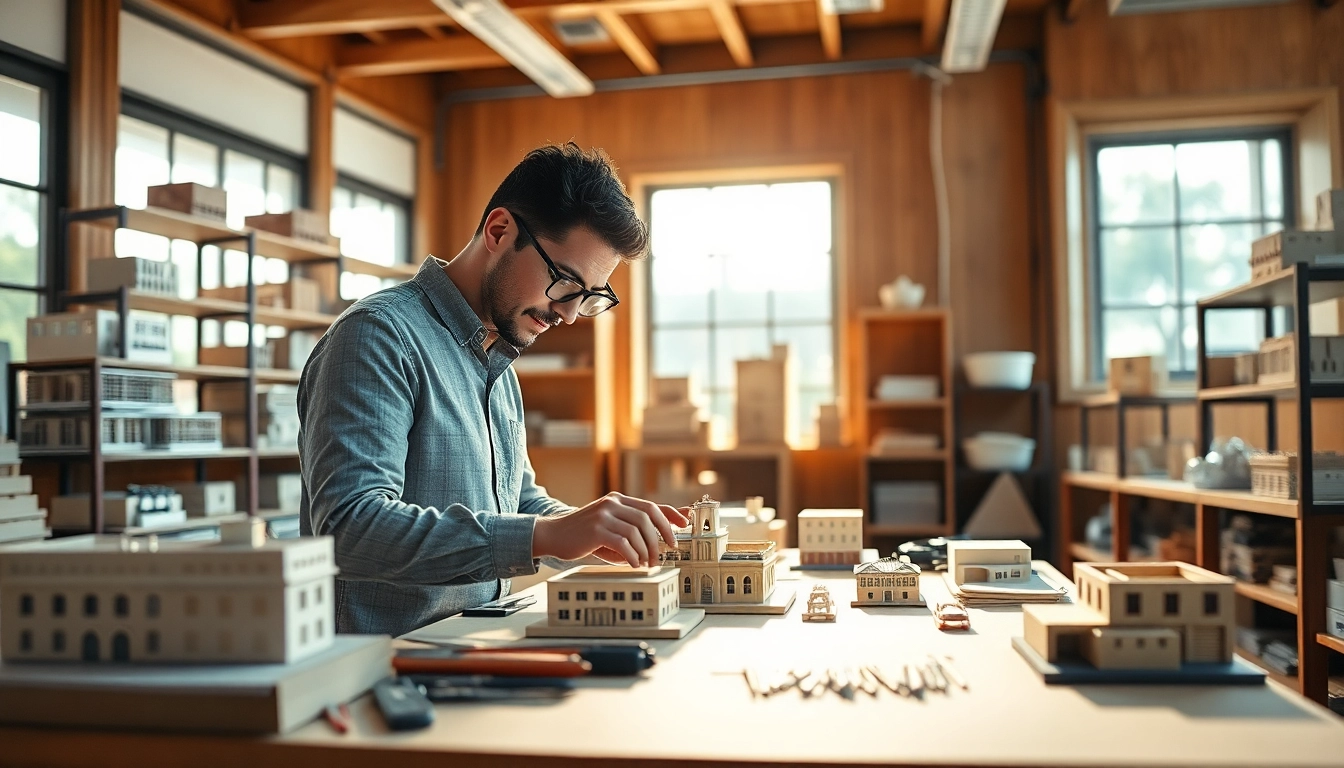Understanding the Architectural Model Maker Biennale
The Architectural Model Maker Biennale, held every two years in conjunction with the prestigious Venice Biennale, showcases the exquisite craft and artistry inherent in architectural model making. This event has become a hallmark of creativity and innovation in the field, attracting architects, designers, and model makers from around the globe. As the interest in architectural models grows, so does the impact of this Biennale on how we perceive architecture and design. This comprehensive overview will delve into the significance of the event, its historical evolution, and key contributions made by model makers that have shaped the architectural landscape.
What is the Biennale and its Significance for Model Makers?
The Venice Biennale, particularly the Architecture Biennale, is renowned as one of the most important occasions for showcasing cutting-edge design and architectural projects worldwide. The Biennale creates a platform where innovation intersects with artistic expression, encouraging experimentation and dialogue. The inclusion of architectural model makers highlights their vital role in the design process; models serve as tangible representations of conceptual ideas, making them critical for visual communication among architects and clients. The architectural model maker Biennale thus recognizes these artisans’ contributions, offering them a distinctive stage to showcase their skills and craftsmanship.
Historical Context and Evolution of Model Making at the Biennale
Model making has a storied history in architecture, evolving significantly over the centuries. In the early days, models were primarily functional, serving as tools for measurements and plans. As architectural styles changed and technology advanced, so did the intricacies and scopes of these models. Initially showcased in the Venice Biennale in the mid-20th century, architectural models were primarily static representations, but over time they have incorporated interactive elements and multimedia, reflecting the evolution of architectural ideas.
The Biennale began to embrace model making as a serious artistic discipline in the late 20th century, recognizing its potential to bring complex architectural concepts to life. This evolution has given rise to specialized categories within the Biennale, focusing explicitly on the artistic merit of model making, thus impacting both the profession and industry standards.
Key Contributions and Movements in Architectural Model Making
Architectural model makers have been exponentiating their craft, contributing to movements that emphasize sustainability, social responsibility, and technological advancements. Notable architects have often collaborated with model makers, using them as integral parts of the design and presentation process. For instance, during the last Biennale, several installations showcased groundbreaking sustainable practices through miniaturized, detailed models that demonstrated innovative solutions to urban challenges.
Moreover, contemporary debates surrounding architecture, such as inclusivity and community engagement, have been expressed through models displayed at the Biennale. These contributions highlight how model making has expanded beyond mere representation to embody critical discourse in architecture, offering insights into future possibilities and challenges.
Skills and Techniques for Architectural Model Makers
The craft of model making requires a multitude of skills, ranging from technical expertise to artistic sensibility. As the demand for compelling architectural models continues to rise, the necessary skill set for aspiring model makers has become increasingly diverse.
Essential Skills for Becoming an Architectural Model Maker
Becoming a proficient architectural model maker necessitates a blend of artistic creativity and technical acumen. Key skills include:
- Design Skills: Understanding design principles is crucial for translating concepts into tangible models.
- Attention to Detail: Precision and meticulous attention ensure the accuracy of the final model, making details critical.
- Material Knowledge: Familiarity with various materials, such as wood, plastic, and foam, enables the selection of the right medium for each project.
- Technical Proficiency: Knowing how to use tools like laser cutters, 3D printers, and traditional hand tools enhances one’s capacity to create intricate designs.
- Problem-Solving Skills: Every project presents unique challenges; the ability to innovate and adapt is essential.
Tools and Materials Commonly Used in Architectural Model Making
The tools and materials employed in architectural model making vary broadly, depending on the complexity and scope of the projects. Key items include:
- Main Tools: X-Acto knives, hot glue guns, and laser cutters are staples in many model makers’ toolkits.
- Materials: Common materials range from cardboard and foam board to advanced options like acrylic and 3D printed components.
- Construction Techniques: Various techniques, such as laser cutting and CAD modeling, are often combined to produce detailed and accurate models.
Advanced Techniques for Intricate and Precise Models
As technology evolves, so do the techniques employed by architectural model makers. Some advanced techniques include:
- 3D Printing: This transformative technology allows for intricate designs and rapid prototyping, offering new dimensions to model making.
- CNC Machining: Computer Numerical Control (CNC) milling enables precise cutting and shaping of materials, enhancing detail in models.
- Interactive Models: Incorporating electronics and digital interfaces into models has brought an interactive dimension, allowing them to be more engaging and informative.
The Role of Model Making in Architecture
Architectural models function as essential tools in the design process, serving various vital roles that influence the trajectory of architectural projects. Their creation is an amalgamation of artistic insight and practical engineering.
How Architectural Models Influence Design Concepts
Models influence the design process by providing architects and designers with a tangible representation of spatial relationships and aesthetics. They serve not only as visual aids but also as testing grounds for ideas, allowing for alterations and refinements before construction begins. Feedback from both clients and stakeholders can be more effectively communicated through a physical model, facilitating collaborative discussions that may enhance project outcomes. Furthermore, models can help identify potential design flaws in the early stages, thereby reducing costs and streamlining the entire architectural process.
Case Studies of Iconic Models Showcased at the Biennale
Throughout the years, the Venice Biennale has seen numerous iconic models that have pushed the boundaries of architectural expression. For example, the models created for the “Fundamentals” exhibition highlighted key elements of architectural education, showcasing various design philosophies through a series of stunning models. Another noteworthy example is the model developed for the “Arctic Adaptations” installation, which creatively addressed climate change issues through innovative design and material use.
The Relationship Between Digital and Physical Model Making
The relationship between digital and physical model making is symbiotic, offering architects an integrated approach to realize their visions. Digital modeling software enables architects to envision complex structures accurately; however, those visions must often be brought into the physical realm for both presentation and practical evaluation. Techniques like 3D printing allow for accurate translation of digital designs into physical models, hence bridging the gap between concept and realization.
Participating in the Architectural Model Maker Biennale
For model makers and designers eager to participate in the Architectural Model Maker Biennale, understanding the application process and what to expect is crucial for a successful experience.
Application Process and Criteria for Participation
Typically, the process for participating in the Biennale involves submitting detailed proposals that outline the intended projects, methodologies, and objectives. Each year, the Biennale has specific themes that guide submissions, so adhering to these is essential. Criteria often include:
- Alignment with the Biennale’s overarching theme.
- Originality and innovation of the model or concept.
- Technical proficiency demonstrated in the model making process.
- Relevance to contemporary architectural discussions.
What to Expect: Networking Opportunities and Presentations
Attending the Biennale offers unparalleled networking opportunities for model makers and architects alike. Collaborating with other professionals can lead to partnerships and insights that enhance one’s skill set and exposure in the field. Presentations by renowned architects, workshops, and lectures also contribute to a dynamic learning environment that fosters professional growth.
Showcasing Your Work: Tips for a Successful Exhibition
Exhibiting at the Biennale is a significant opportunity, and there are several key considerations to ensure a successful display:
- Focus on Presentation: The aesthetic and functional presentation of the model is critical; lighting, signage, and placement can all impact viewer engagement.
- Engagement Strategies: Interactive elements or touch points can help visitors connect with the model on a deeper level.
- Prepare for Questions: Being ready to discuss your craft and creative process allows for meaningful interactions with curious attendees.
Future Trends in Architectural Model Making
As architectural practices evolve, so too does model making. Innovations and forward-thinking approaches in the field are shaping the future of how these tools are utilized across design disciplines.
Innovations and Technologies Shaping the Future of Model Making
Emerging technologies are fundamentally altering the model-making landscape, with trends such as the rise of virtual and augmented reality being at the forefront. These technologies allow architects to create immersive experiences and spatial analyses that were unimaginable a decade ago. Through VR, stakeholders can traverse a project in a virtual space, facilitating a more comprehensive understanding and aiding in design decisions before any physical work begins.
Sustainability Challenges and Solutions in the Industry
Sustainability is increasingly becoming a focal point within architecture and, by extension, within architectural model making. In response to environmental challenges, model makers are exploring eco-friendly materials, reducing waste in the production process, and promoting sustainable design principles. The Biennale is a critical platform for discussing these innovative practices and advocating for responsible approaches to architectural craftsmanship.
How the Biennale is Adapting to New Design Paradigms
The Venice Biennale has shown a remarkable ability to adapt to contemporary design paradigms, continually evolving its themes to address pressing global issues such as climate change, urbanization, and social equity. The model making segment of the Biennale is integrating these themes, encouraging participants to explore new ways of representing their ideas and solutions through models. This adaptability is crucial to ensuring that the Biennale remains relevant and impactful in future conversations around architecture.



